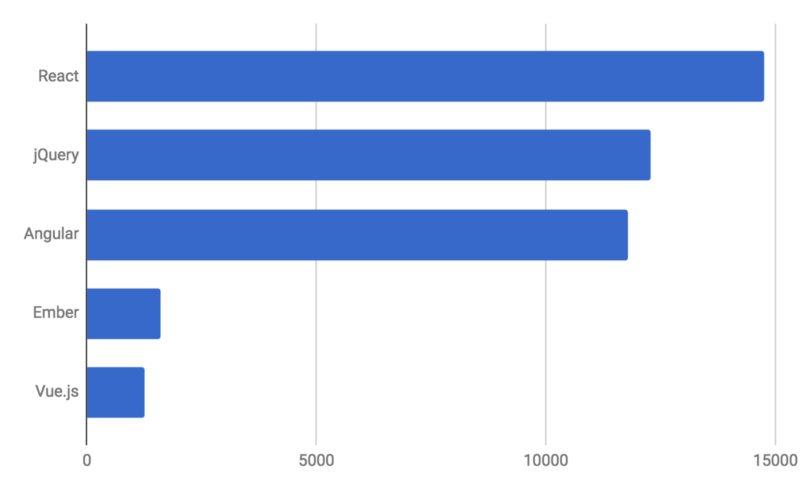React has been on the rise for quite some time – studies and IT specialists agree. More and more developers are learning and using it to build dynamic, high traffic web applications. When searching for React approaches online, there’s no shortage of “how to” articles and debates on why this framework is one of the best out there.
Is 2018 the Year of React?
This topic sparked my curiosity. Last year, Pentalog published two articles (Angular and React comparative analysis and AngularJS and ReactJS ) about the most popular JavaScript frameworks used by developers. At that point, it seemed like Angular just could not be dethroned by React.
But, today we are seeing that although there are still many developers working on Angular code base, React continues to gather momentum at a steadier rate.
Here are some facts that you can no longer afford to ignore about the rise of React. Maybe the moment has come to make your choice.
What do Studies Say?
Google Trends show how the interest in React gained traction in 2016. Another striking fact is the growing number of downloads per month in 2017 for React. For a more in depth view of how React compares to other libraries and frameworks, check out State of JS.

- In a 2016 StackOverflow developer survey, the data showed that React’s popularity had increased by over 300% – a striking statistic.
- In the 2017 developer survey, Stackoverflow noted that React is still among the most popular.
- The fact that React has exploded in popularity is also shown by the JavaScript libraries market reports as well as many other studies found online.
React Rise in Job Listings
React was the most requested JavaScript framework of 2017 with almost 15,000 searches, approximately 3x more than in 2016, according to Indeed.com’s 2017 job search listing.

The stackoverflow blog showed the rise of React in 2016, in the article about developer hiring trends in 2017. The following year, the same survey showed demand for React skills as the fastest growing area of expertise.
There are approximately 450 ReactJS profiles visible on LinkedIn, according to SkillValue recruitment specialists in Romania.
“The market is still young and there are not that many developers with extensive React experience. But we can see a bigger and bigger number of job openings looking for React experience and also an intensification of the trainings available on ReactJS or React Native. SkillValue has started organizing constant free React Native classes, first in France, but we also intend to share our knowledge to Romanian developers…so stay tuned.” – Georgiana Poteca, Head of Recruitment at SkillValue.
If you have already tackled some ReactJS projects, benchmark your technical knowledge against other software specialists by taking this ReactJS medium level quiz. After passing, you’ll receive a certification badge, publishable on your LinkedIn profile.
This 20-minute evaluation was passed by over 800 developers from almost 100 countries, with the majority of them in France, Romania, UK and the U.S.
Where to Start?
If you check Quora and Stackoverflow communities you will see the numerous discussions about the advantages of learning React, including talks about competition on the job market, the learning curve, and the fun you have when coding with React.
The Facebook-backed project has garnered a lot of community support, which is very important to developers looking to learn it.
There are also many free or paid courses on React. And, for developers already familiarized with React, additional courses can be found for React Native, allowing you to easily bring websites to the mobile environment (iOS and Android).

React is currently one of the most popular JavaScript libraries developed by Facebook and it has strong foundation and large community behind it. Check out one of Pentalog’s projects built with React! Do you have any questions? Contact us!
Why Choose React?
1. Easy to Learn & Use.
JSX – React’s method of generating pages allows developers to efficiently set up, understand, and work with complex, multi-feature applications.
2. Reusable Components
React uses a component-based structure that enables you to start small and work towards larger components as development progresses. For instance, you can start with small presentation components such as dropdowns, buttons, or checkboxes and then use them to create large wrapper components. This approach allows developers to create large, complex applications using few, well-defined base elements.
3. Great Toolset for Developers
NPM – JavaScript’s main hub for libraries of all kinds is currently home to over 48,000 React components. This allows developers to pick and choose tools written by other developers that are best suited to their needs without having to reinvent the wheel.
4. Fast Rendering with Virtual DOM
It goes without saying that a critical factor when choosing a framework is performance. This is even more important if you are developing a mobile application that will involve a high number of user interactions and constant updates. React’s Virtual DOM allows an application to run faster by reducing the number of updates your browser has to make behind the scenes.
5. Testability
When using React to develop mobile applications, you can easily test its features. One of the reasons why React applications are so easy to test is because its views can be treated as functions of a specific state. This allows developers to easily and efficiently test each part of an application with minimal effort.
BONUS
One of the best features of React is that it can run on the client side as well as can be rendered on the server side allowing for faster load times and better SEO performance. It is widely used for building web applications and user interfaces.
Choosing Libraries & Tools
The React-versus debate is still a heated one among developers and companies alike. However, some frameworks do fit specific projects better than others do. One thing is certain – React is here for the long haul, allowing for new and innovative ways to bring applications to life.
Examine your project from several different angles like maturity, size, dependencies, interoperability, features, etc., before deciding which libraries and tools best suit your project needs.









